NADPH Oxidase 5 Induces Changes in the Unfolded Protein Response in Human Aortic Endothelial Cells and in Endothelial-Specific Knock-in Mice
Abstract
1. Introduction
2. Materials and Methods
2.1. Cell Culture
2.2. Adenovirus Transduction
2.3. Transcriptome Analysis
2.4. Real-Time Quantitative Polymerase Chain Reaction
2.5. Western Blot Analysis
2.6. Reactive Oxygen Species Determination
2.7. Caspase Activity Assay
2.8. Proteasome Activity Measurement
2.9. Conditional Knock-in Mice
2.10. Statistical Analysis
3. Results
3.1. In Vitro Model Characterization
3.2. Transcriptome Analysis in HAEC
3.3. Validation of NOX5-β Overexpression on the Levels of the UPR Components Genes in HAEC
3.4. Effects of NOX5-β Overexpression on the UPR Components Protein Levels in HAEC
3.5. Proteasome Activity and Apoptosis Determination
3.6. UPR Components Gene Expression in Knock-in Mice
4. Discussion
5. Conclusions
Supplementary Materials
Author Contributions
Funding
Institutional Review Board Statement
Informed Consent Statement
Data Availability Statement
Acknowledgments
Conflicts of Interest
References
- World Health Organization. World Health Statistics 2018. Available online: https://www.who.int/gho/publications/world_health_statistics/2018/EN_WHS2018_TOC.pdf?ua=1 (accessed on 11 November 2020).
- World Health Organization. World Health Statistics 2012. Available online: https://apps.who.int/iris/bitstream/handle/10665/44844/9789241564441_eng.pdf;jsessionid=3CD5CB157062BF4D6BBEAA43FCDD5355?sequence=1 (accessed on 11 November 2020).
- Channon, K.M.; Guzik, T.J. Mechanisms of superoxide production in human blood vessels: Relationship to endothelial dysfunction, clinical and genetic risk factors. J. Physiol. Pharmacol. 2002, 53, 515–524. [Google Scholar] [PubMed]
- He, F.; Zuo, L. Redox roles of reactive oxygen species in cardiovascular diseases. Int. J. Mol. Sci. 2015, 16, 27770–27780. [Google Scholar] [CrossRef] [PubMed]
- Johansen, J.S.; Harris, A.K.; Rychly, D.J.; Ergul, A. Oxidative stress and the use of antioxidants in diabetes: Linking basic science to clinical practice. Cardiovasc. Diabetol. 2005, 4, 5. [Google Scholar] [CrossRef] [PubMed]
- Jha, J.C.; Watson, A.M.D.; Mathew, G.; de Vos, L.C.; Jandeleit-Dahm, K. The emerging role of NADPH oxidase NOX5 in vascular disease. Clin. Sci. 2017, 131, 981–990. [Google Scholar] [CrossRef]
- Hahn, N.E.; Meischl, C.; Kawahara, T.; Musters, R.J.; Verhoef, V.M.J.; van der Velden, J.; Vonk, A.B.A.; Paulus, W.J.; van Rossum, A.C.; Niessen, H.W.M.; et al. NOX5 Expression is increased in intramyocardial blood vessels and cardiomyocytes after acute myocardial infarction in humans. Am. J. Pathol. 2012, 80, 2222–2229. [Google Scholar] [CrossRef]
- Zhang, Y.; Murugesan, P.; Huang, K.; Cai, H. NADPH oxidases and oxidase crosstalk in cardiovascular diseases: Novel therapeutic targets. Nat. Rev. Cardiol. 2020, 17, 170–194. [Google Scholar] [CrossRef]
- Drummond, G.R.; Selemidis, S.; Griendling, K.K.; Sobey, C.G. Combating oxidative stress in vascular disease: NADPH oxidases as therapeutic targets. Nat. Rev. Drug Discov. 2011, 10, 453–471. [Google Scholar] [CrossRef]
- Chen, F.; Wang, Y.; Barman, S.; Fulton, D.J.R. Enzymatic regulation and functional relevance of NOX5. Curr. Pharm. Des. 2015, 21, 5999–6008. [Google Scholar] [CrossRef]
- Fulton, D.J.R. Nox5 and the regulation of cellular function. Antioxid. Redox Signal. 2009, 11, 2443–2452. [Google Scholar] [CrossRef]
- BelAiba, R.S.; Djordjevic, T.; Petry, A.; Diemer, K.; Bonello, S.; Banfi, B.; Hess, J.; Pogrebniak, A.; Bickel, C.; Görlach, A. NOX5 variants are functionally active in endothelial cells. Free Radic. Biol. Med. 2007, 42, 446–459. [Google Scholar] [CrossRef]
- Armstrong, J.S.; Bivalacqua, T.J.; Chamulitrat, W.; Sikka, S.; Hellstrom, W.J.G. A comparison of the NADPH oxidase in human sperm and white blood cells. Int. J. Androl. 2002, 25, 223–229. [Google Scholar] [CrossRef]
- Millana Fañanás, E.; Todesca, S.; Sicorello, A.; Masino, L.; Pompach, P.; Magnani, F.; Pastore, A.; Mattevi, A. On the mechanism of calcium-dependent activation of NADPH oxidase 5 (NOX5). FEBS J. 2020, 287, 2486–2503. [Google Scholar] [CrossRef] [PubMed]
- Guzik, T.J.; Chen, W.; Gongora, M.C.; Guzik, B.; Lob, H.E.; Mangalat, D.; Hoch, N.; Dikalov, S.; Rudzinski, P.; Kapelak, B.; et al. Calcium-dependent NOX5 nicotinamide adenine dinucleotide phosphate oxidase contributes to vascular oxidative stress in human coronary artery disease. J. Am. Coll Cardiol. 2008, 52, 1803–1809. [Google Scholar] [CrossRef] [PubMed]
- Jha, J.C.; Banal, C.; Okabe, J.; Gray, S.P.; Hettige, T.; Chow, B.S.M.; Thallas-Bonke, V.; de Vos, L.; Holterman, C.E.; Coughlan, M.T.; et al. NADPH oxidase Nox5 accelerates renal injury in diabetic nephropathy. Diabetes 2017, 10, 2691–2703. [Google Scholar] [CrossRef] [PubMed]
- Liu, M.Q.; Chen, Z.; Chen, L.X. Endoplasmic reticulum stress: A novel mechanism and therapeutic target for cardiovascular diseases. Acta Pharmacol. Sin. 2016, 37, 425–443. [Google Scholar] [CrossRef]
- Sozen, E.; Karademir, B.; Ozer, N.K. Basic mechanisms in endoplasmic reticulum stress and relation to cardiovascular diseases. Free Radic. Biol. Med. 2015, 78, 30–41. [Google Scholar] [CrossRef]
- Ron, D.; Walter, P. Signal integration in the endoplasmic reticulum unfolded protein response. Nat. Rev. Mol. Cell Biol. 2007, 8, 519–529. [Google Scholar] [CrossRef]
- Petry, A.; Zhang, Z.; Trautz, B.; Rieß, F.; Gorlach, A. Cross talk between p22phox and ATF4 in the endothelial unfolded protein response. Antioxid. Redox Signal. 2019, 30, 40–55. [Google Scholar] [CrossRef]
- Zeeshan, H.M.; Lee, G.H.; Kim, H.R.; Chae, H.J. Endoplasmic reticulum stress and associated ROS. Int. J. Mol. Sci. 2016, 17, 327. [Google Scholar] [CrossRef]
- Lee, H.Y.; Kim, H.K.; Hoang, T.H.; Yang, S.; Kim, H.R.; Chae, H.J. The correlation of IRE1α oxidation with Nox4 activation in aging-associated vascular dysfunction. Redox Biol. 2020, 37, 101727. [Google Scholar]
- Santos, C.X.C.; Nabeebaccus, A.A.; Shah, A.M.; Caramago, L.L.; Filho, S.V.; Lopes, L.R. Endoplasmic reticulum stress and Nox-mediated reactive oxygen species signaling in the peripheral vasculature: Potential role in hypertension. Antioxid. Redox Signal. 2014, 20, 121–134. [Google Scholar] [CrossRef] [PubMed]
- Neves, K.B.; Harvey, A.P.; Moreton, F.; Montezano, A.C.; Rios, F.J.; Alves-Lopes, R.; Nguyen Dinh Cat, A.; Rocchicciolli, P.; Delles, C.; Joutel, A.; et al. ER stress and Rho kinase activation underlie the vasculopathy of CADASIL. JCI Insight 2019, 4, 131344. [Google Scholar] [CrossRef] [PubMed]
- Andueza, A.; Garde, N.; García-Garzón, A.; Ansorena, E.; López-Zabalza, M.J.; Iraburu, M.J.; Zalba, G.; Martínez-Irujo, J.J. NADPH oxidase 5 promotes proliferation and fibrosis in human hepatic stellate cells. Free Radic. Biol. Med. 2018, 126, 15–26. [Google Scholar] [CrossRef] [PubMed]
- Irizarry, R.A.; Bolstad, B.M.; Collin, F.; Cope, L.M.; Hobbs, B.; Speed, T.P. Summaries of affymetrix genechip probe level data. Nucleic Acids Res. 2003, 31, e15. [Google Scholar]
- Gentleman, R.C.; Carey, V.J.; Bates, D.M.; Bolstad, B.; Dettling, M.; Dudoit, S.; Ellis, B.; Gautier, L.; Ge, Y.; Gentry, J.; et al. Bioconductor: Open software development for computational biology and bioinformatics. Genome Biol. 2004, 5, R80. [Google Scholar] [CrossRef]
- Smyth, G.K. Linear models and empirical bayes methods for assessing differential expression in microarray experiments. Stat. Appl. Genet. Mol. Biol. 2004, 3, Article3. [Google Scholar] [CrossRef]
- Dao, V.T.; Elbatreek, M.H.; Altenhöfer, S.; Casas, A.I.; Pachado, M.P.; Neullens, C.T.; Knaus, U.G.; Schmidt, H.H.H.W. Isoform-selective NADPH oxidase inhibitor panel for pharmacological target validation. Free Radic. Biol. Med. 2019, 148, 60–69. [Google Scholar] [CrossRef]
- Wang, Y.; Nakayama, M.; Pitulescu, M.E.; Schmidt, T.S.; Bochenek, M.L.; Sakakibara, A.; Adams, S.; Davy, A.; Deutsch, U.; Lüthi, U.; et al. Ephrin-B2 controls VEGF-induced angiogenesis and lymphangiogenesis. Nature 2010, 465, 483–486. [Google Scholar] [CrossRef]
- Marqués, J.; Cortés, A.; Pejenaute, Á.; Ansorena, E.; Abizanda, G.; Prósper, F.; Martínez-Irujo, J.J.; de Miguel, C.; Zalba, G. Induction of cyclooxygenase-2 by overexpression of the human NADPH oxidase 5 (NOX5) gene in aortic endothelial cells. Cells 2020, 6, 637. [Google Scholar]
- Cominacini, L.; Mozzini, C.; Garbin, U.; Pasini, A.; Stranieri, C.; Solani, E.; Vallerio, P.; Tinelli, I.A.; Fratta Pasini, A. Endoplasmic reticulum stress and Nrf2 signaling in cardiovascular diseases. Free Radic. Biol. Med. 2015, 88, 233–242. [Google Scholar] [CrossRef]
- Lenna, S.; Han, R.; Trojanowska, M. Endoplasmic reticulum stress and endothelial dysfunction. IUBMB Life 2014, 66, 530–537. [Google Scholar] [CrossRef] [PubMed]
- Niforou, K.; Cheimonidou, C.; Trougakos, I.P. Molecular chaperones and proteostasis regulation during redox imbalance. Redox Biol. 2014, 2, 323–332. [Google Scholar] [CrossRef] [PubMed]
- Laurindo, F.R.; Araujo, T.L.; Abrahão, T.B. Nox NADPH oxidases and the endoplasmic reticulum. Antioxid. Redox Signal. 2014, 20, 2755–2775. [Google Scholar] [CrossRef]
- Janiszewski, M.; Lopes, L.R.; Carmo, A.O.; Pedro, M.A.; Brandes, R.P.; Santos, C.X.; Laurindo, F.R. Regulation of NAD(P)H oxidase by associated protein disulfide isomerase in vascular smooth muscle cells. J. Biol. Chem. 2005, 280, 40813–40819. [Google Scholar] [CrossRef]
- Prior, K.K.; Wittig, I.; Leisegang, M.S.; Groenendyk, J.; Weissmann, N.; Michalak, M.; Jansen-Dürr, P.; Shah, A.M.; Brandes, R.P. The endoplasmic reticulum chaperone calnexin is a NADPH oxidase NOX4 interacting protein. J. Biol. Chem. 2016, 291, 7045–7059. [Google Scholar] [CrossRef]
- Chen, F.; Yu, Y.; Qian, J.; Wang, Y.; Cheng, B.; Dimitropoulou, C.; Patel, V.; Chadli, A.; Rudic, R.D.; Stepp, D.W.; et al. Opposing actions of heat shock protein 90 and 70 regulate nicotinamide adenine dinucleotide phosphate oxidase stability and reactive oxygen species production. Arterioscler. Thromb Vasc. Biol. 2012, 32, 2989–2999. [Google Scholar] [CrossRef]
- Hotamisligil, G.S.; Davis, R.J. Cell signaling and stress responses. Cold Spring. Harb. Perspec. Biol. 2016, 3, 8. [Google Scholar]
- Bertolotti, A.; Zhang, Y.; Hendershot, L.M.; Harding, H.P.; Ron, D. Dynamic interaction of BiP and the ER stress transducers in the unfolded protein response. Nature Cell Biol. 2000, 2, 326–332. [Google Scholar] [CrossRef]
- Shen, J.; Chen, X.; Hendershot, L.; Prywes, R. ER stress regulation of ATF6 localization by dissociation of BiP/GRP78 and unmasking of Golgi localization signals. Dev. Cell 2002, 3, 99–111. [Google Scholar] [CrossRef]
- Brown, D.I.; Griendling, K.K. Regulation of signal transduction by reactive oxygen species in the cardiovascular system. Circ. Res. 2015, 116, 531–549. [Google Scholar]
- Nishitoh, H. CHOP is a multifunctional transcription factor in the ER stress response. J. Biochem. 2012, 151, 217–219. [Google Scholar] [CrossRef] [PubMed]
- Fan, Y.; Simmen, T. Mechanistic connections between endoplasmic reticulum (ER) redox control and mitochondrial metabolism. Cells 2019, 8. [Google Scholar] [CrossRef] [PubMed]
- Braunstein, H.; Maor, G.; Chicco, G.; Filocamo, M.; Zimran, A.; Horowitz, M. UPR activation and CHOP mediated induction of GBA1 transcription in Gaucher disease. Blood Cells Mol. Dis. 2018, 68, 21–29. [Google Scholar] [CrossRef] [PubMed]
- Harvey, A.; Montezano, A.C.; Touyz, R.M. Vascular biology of ageing—Implications in hypertension. J. Mol. Cell Cardiol. 2015, 83, 112–121. [Google Scholar] [CrossRef] [PubMed]
- Galán, M.; Kassan, M.; Kadowitz, P.J.; Trebak, M.; Belmadani, S.; Matrougui, K. Mechanism of endoplasmic reticulum stress-induced vascular endothelial dysfunction. Biochim. Biophys. Acta 2014, 1843, 1063–1075. [Google Scholar] [CrossRef]
- Choi, S.K.; Lim, M.; Byeon, S.H.; Lee, Y.H. Inhibition of endoplasmic reticulum stress improves coronary artery function in the spontaneously hypertensive rats. Sci. Rep. 2016, 6, 31925. [Google Scholar] [CrossRef]

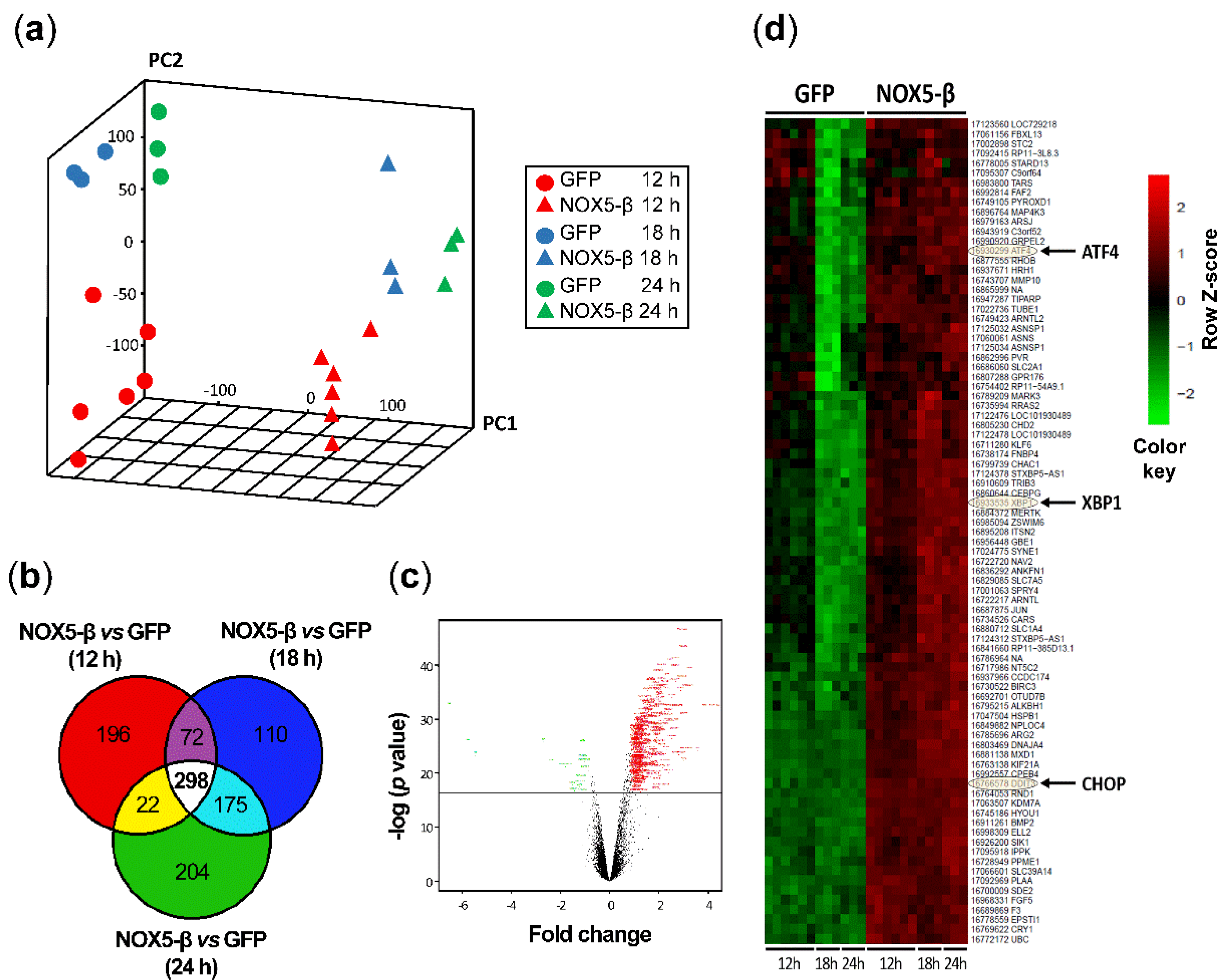
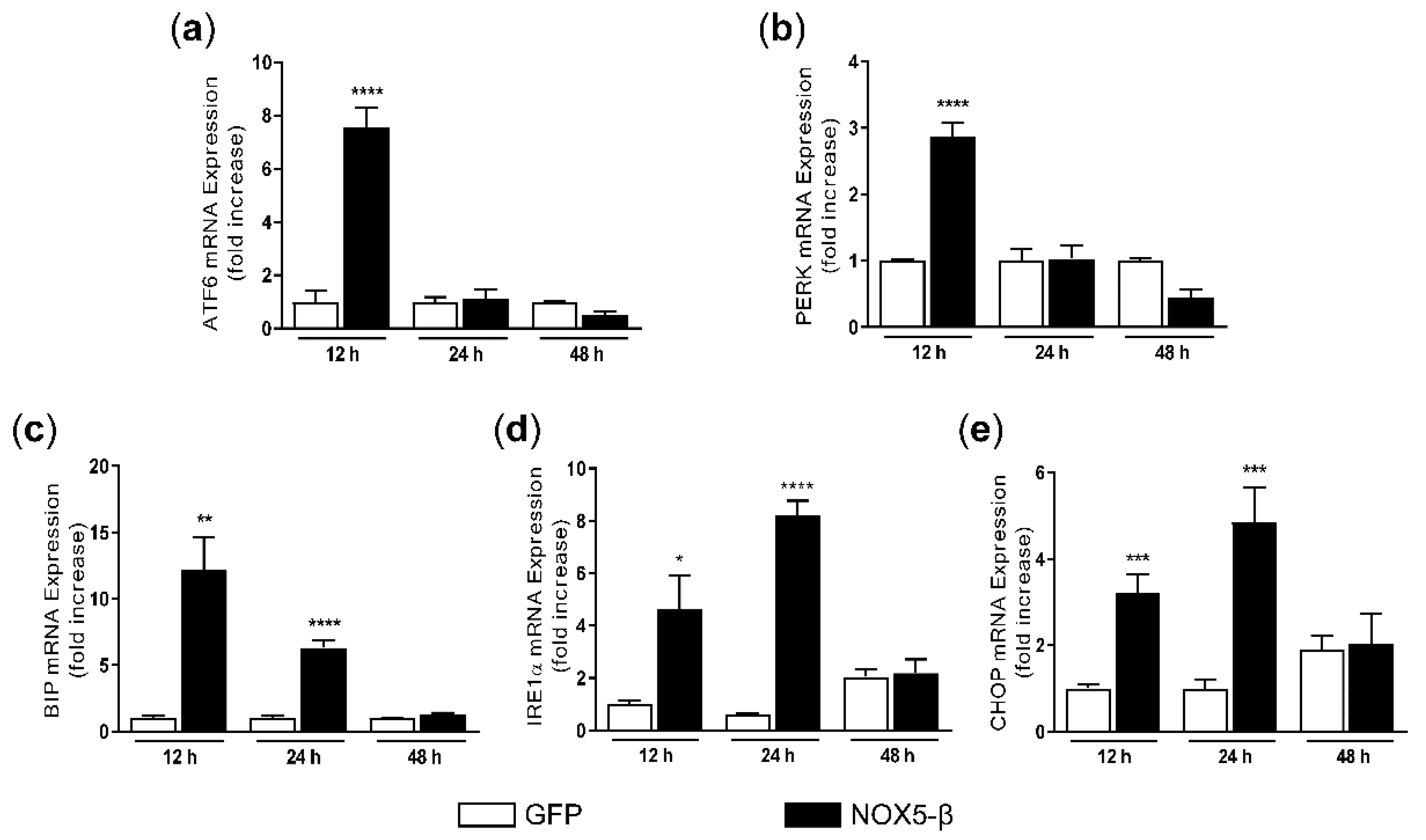
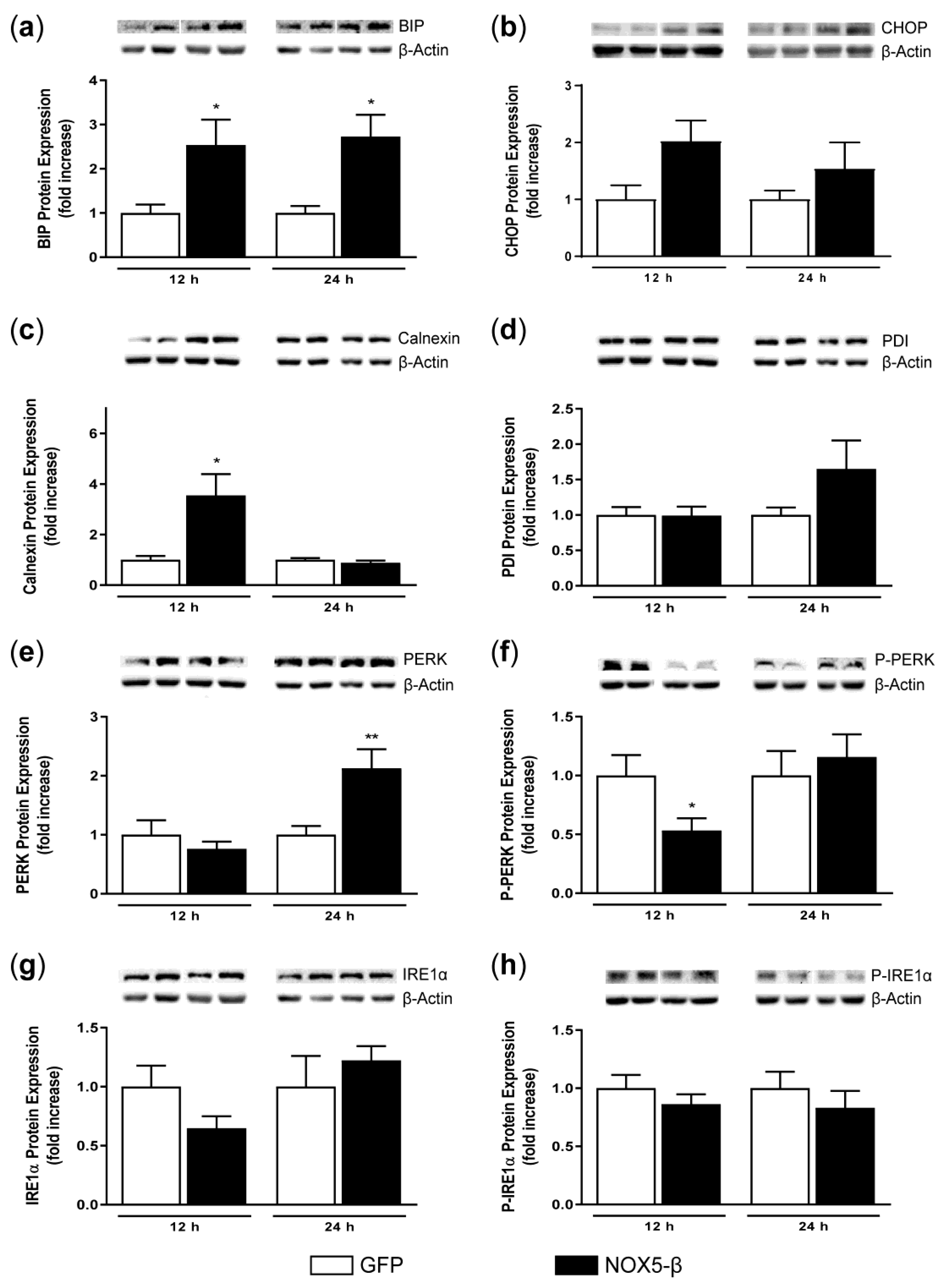
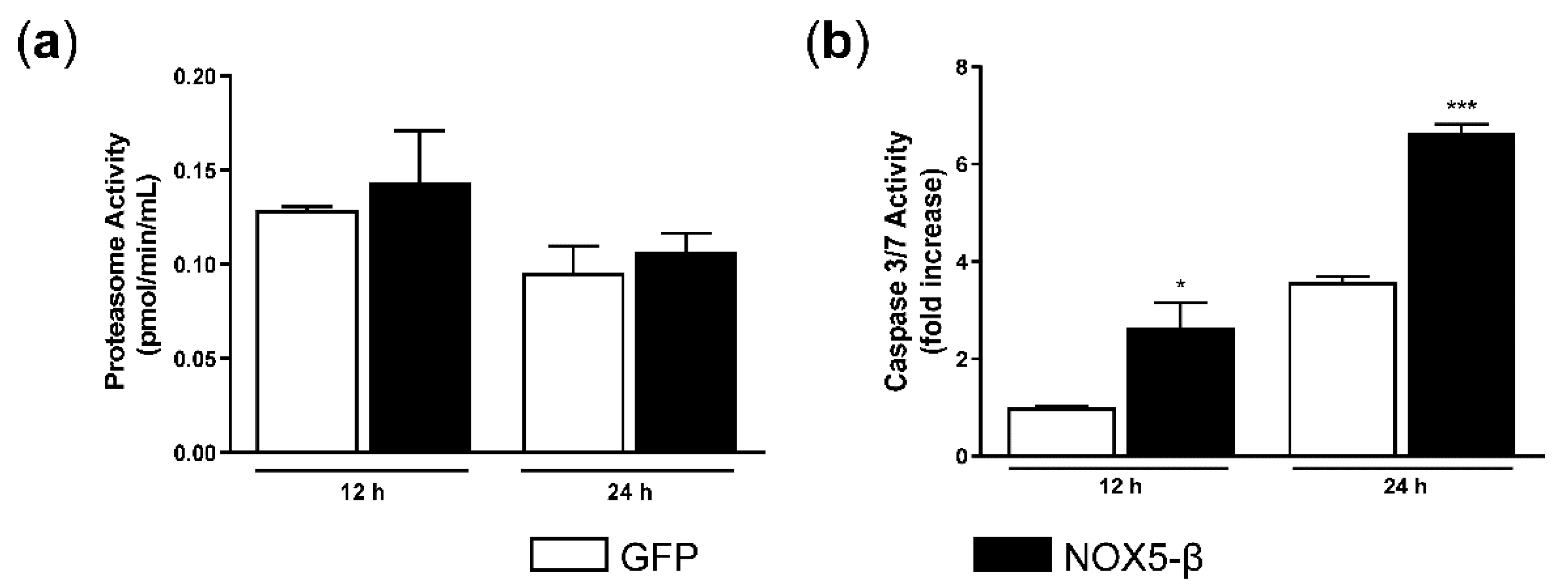
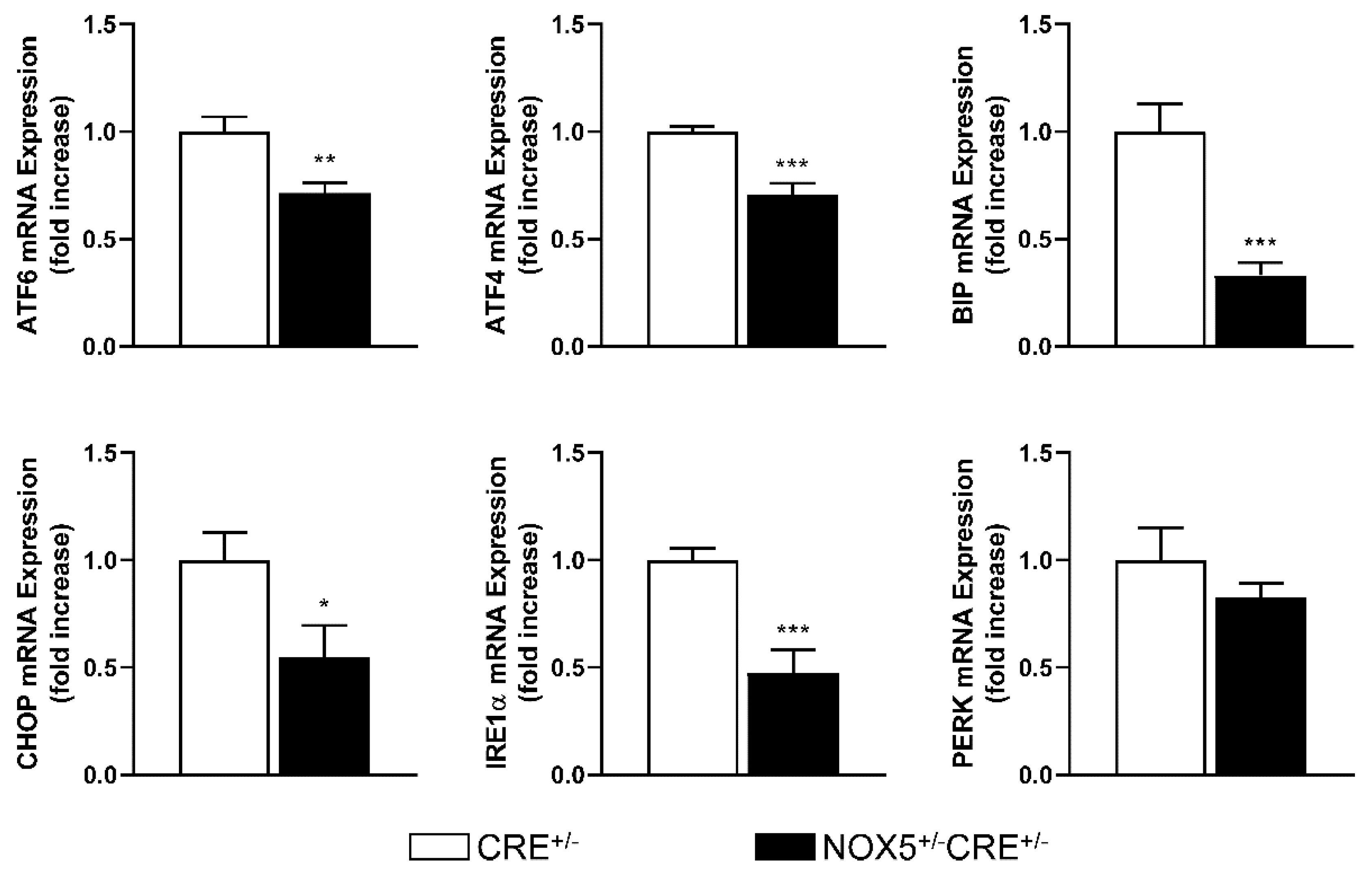

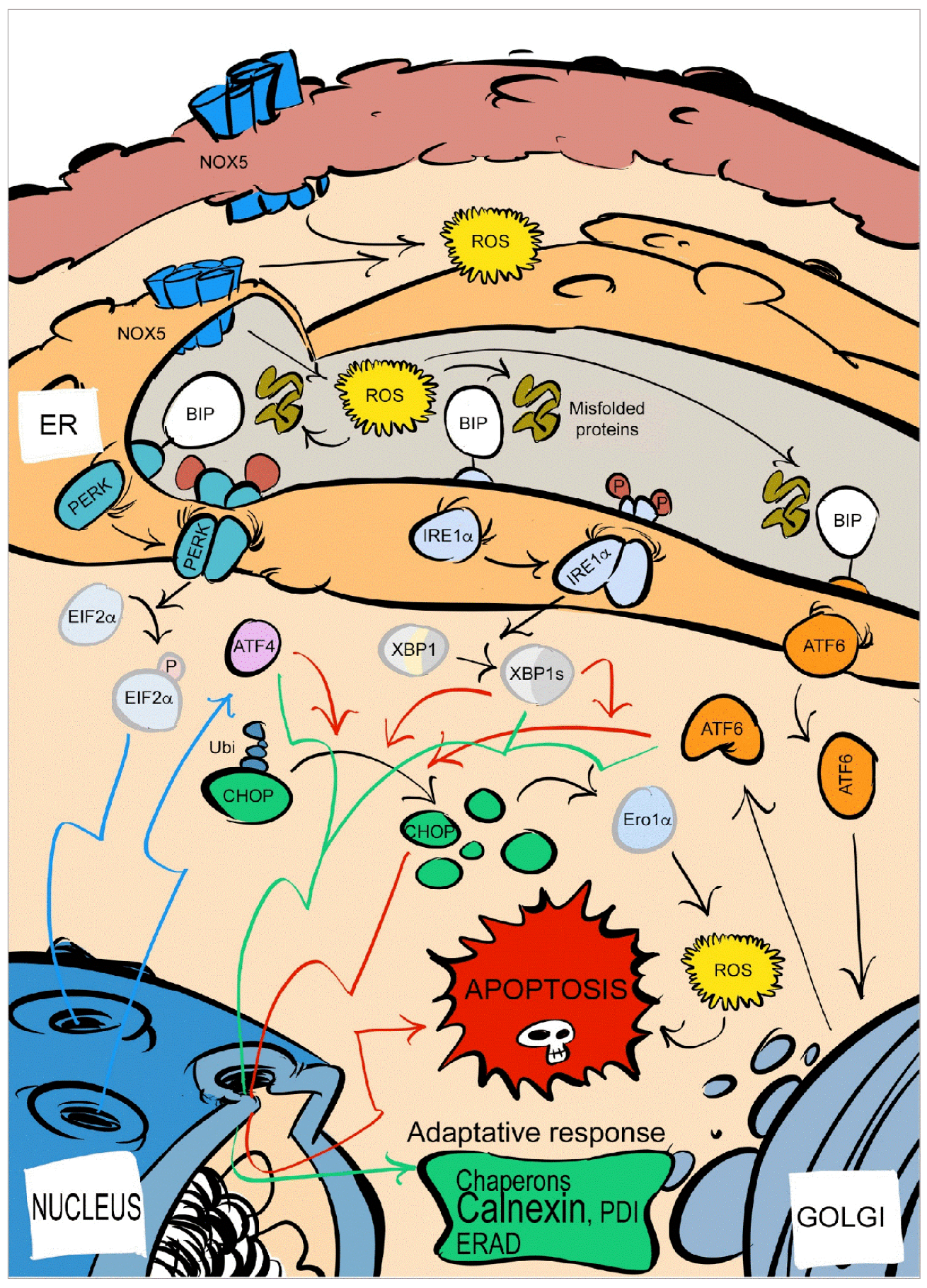
| Gene | Accession N° | Primers | |
|---|---|---|---|
| Hs ATF6 | NM_007348.4 | forward | 5′-GCTGGATGAAGTTGTGTCAGAG-3′ |
| reverse | 5′-TGTTCCAACATGCTCATAGGTC-3′ | ||
| Hs BIP | NM_005347.5 | forward | 5′-GAGCTGTGCAGAAACTCCGGCG-3′ |
| reverse | 5′-ACCACCTGCTGAATCTTTGGAATTCGAGT-3′ | ||
| Hs IRE1α | NM_001433.5 | forward | 5′-CCGATCGTGAAGCAGTTAGAG-3′ |
| reverse | 5′- AGGTCCTGAATTTACGCAGGT-3′ | ||
| Hs PERK | NM_004836.7 | forward | 5′-CAGGCAAAGGAAGGAGTCTG-3′ |
| reverse | 5′-AACAACTCCAAAGCCACCAC-3′ | ||
| Hs CHOP | NM_001195053.1 | forward | 5′-AGTGCCACGGAGAAAGCTAA-3′ |
| reverse | 5′-CCATACAGCAGCCTGAGTGA-3′ | ||
| Hs NOX5 | NM_001184780.2 | forward | 5′-ATGAGTGCCGAGGAGGATG-3′ |
| reverse | 5′-ATCGATGGCAGTGGCTCCAT-3′ | ||
| Hs GAPDH | NM_001289745.3 | forward | 5′-CCAAGGTCATCCATGACAAC-3′ |
| reverse | 5′-TGTCATACCAGGAAATGAGC-3′ | ||
| Mm ATF6 | NM_001081304.1 | forward | 5′-GATCACTCTGTGTCCAATGACAA-3′ |
| reverse | 5′-TAGATTTGGTCCTTTCCACTTCA-3′ | ||
| Mm ATF4 | NM_009716.3 | forward | 5′-AAACCTCATGGGTTCTCCAG-3′ |
| reverse | 5′-GAGGGGCAAAAAGATCACAT-3′ | ||
| Mm BIP | NM_001163434.1 | forward | 5′-AGGAGACTGCTGAGGCGTAT-3′ |
| reverse | 5′-CCAGGTCAAACACAAGGATG-3′ | ||
| Mm IRE1α | NM_023913.2 | forward | 5′-AATAGAAAAGGAGGCCTTGGAC-3′ |
| reverse | 5′-TGGTGTTTCTTGTTTCTCATGG-3′ | ||
| Mm PERK | NM_001313918.1 | forward | 5′-CGATCAAATGGAAGCCCTTA-3′ |
| reverse | 5′-TGCGGATGTTCTTGCTGTAG-3′ | ||
| Mm CHOP | NM_007837.4 | forward | 5′-AGGTCCTGTCCTCAGATGAA-3′ |
| reverse | 5′-GACCACTCTGTTTCCGTTTC-3′ | ||
| Mm GAPDH | NM_001289726.1 | forward | 5′-ATGACAACTTTGTCAAGCTCATTT-3′ |
| reverse | 5′-GGTCCACCACCCTGTTGCT-3′ | ||
| Primary Antibody | Brand (Dilution) | Secondary Antibody | Brand (Dilution) | MW (kDa) |
|---|---|---|---|---|
| BIP | Cell Signalling (1:1000) | Anti-rabbit | Cell Signalling (1:2000) | 78 |
| Calnexin | Cell Signalling (1:1000) | Anti-rabbit | Cell Signalling (1:2000) | 90 |
| IRE1α | Cell Signalling (1:1000) | Anti-rabbit | Cell Signalling (1:2000) | 130 |
| P-IRE1α | Thermo Scientific (1:1000) | Anti-rabbit | GE Healthcare (1:2000) | 110 |
| PDI | Cell Signalling (1:1000) | Anti-rabbit | Cell Signalling (1:2000) | 57 |
| PERK | Cell Signalling (1:1000) | Anti-rabbit | Cell Signalling (1:2000) | 140 |
| P-PERK | Cell Signalling (1:1000) | Anti-rabbit | Cell Signalling (1:2000) | 170 |
| CHOP | Cell Signalling (1:500) | Anti-mouse | Cell Signalling (1:2000) | 27 |
| NOX5 | Abcam (1:2000) | Anti-rabbit | Cell Signalling (1:4000) | 86 |
| β-Actin | Sigma-Aldrich (1:10,000) | Anti-mouse | GE Healthcare (1:10,000) | 45 |
| Basal | 2 Days | 28 Days | ||||
|---|---|---|---|---|---|---|
| NOX5+/− CRE+/− | CRE+/− | NOX5+/− CRE+/− | CRE+/− | NOX5+/− CRE+/− | CRE+/− | |
| MV E, mm/s | 889 ± 18 | 900 ± 28 | 742 ± 28 | 726 ± 34 | 680 ± 38 | 655 ± 45 |
| MV A, mm/s | 527 ± 13 | 522 ± 16 | 317 ± 19 | 356 ± 28 | 376 ± 29 | 400 ± 41 |
| MV E/A, AU | 1.70 ± 0.03 | 1.73 ± 0.02 | 2.47 ± 0.17 | 2.12 ± 0.12 | 1.89 ± 0.10 | 1.71 ± 0.07 |
| E’, mm/s | 21.3 ± 0.5 | 20.8 ± 0.6 | 16.3 ± 0.8 | 16.0 ± 0.7 | 18.2 ± 0.9 | 17 ± 80.6 |
| A’, mm/s | 13.1 ± 0.5 | 12.5 ± 0.4 | 9.1 ± 0.5 | 8.6 ± 0.5 | 10.5 ± 0.7 | 10.6 ± 0.7 |
| E’/A’, AU | 1.64 ± 0.05 | 1.67 ± 0.03 | 1.81 ± 0.06 | 1.89 ± 0.06 | 1.77 ± 0.05 | 1.73 ± 0.07 |
| IVCT, ms | 8.83 ± 0.24 | 9.38 ± 0.36 | 10.75 ± 0.42 | 10.87 ± 0.64 | 10.80 ± 0.78 | 11.60 ± 1.03 |
| IVRT, ms | 13.75 ± 0.55 | 13.36 ± 0.60 | 17.92 ± 0.80 | 19.52 ± 0.82 | 20.45 ± 1.41 | 20.69 ± 0.88 |
| a, ms | 76.38 ± 1.80 | 77.34 ± 2.86 | 77.25 ± 2.67 | 80.67 ± 2.88 | 86.79 ± 5.01 | 92.71 ± 3.82 |
| b, ms | 54.02 ± 1.40 | 54.14 ± 2.17 | 45.58 ± 2.00 | 50.29 ± 2.30 | 55.89 ± 3.59 | 60.62 ± 2.58 |
| Index Tei, AU | 1.72 ± 0.01 | 1.43 ± 0.01 | 1.60 ± 0.02 | 1.62 ± 0.04 | 1.56 ± 0.03 | 1.53 ± 2.78 |
| E/E’, AU | 42.08 ± 1.04 | 43.47 ± 1.09 | 46.34 ± 2.01 | 45.74 ± 1.92 | 38.26 ± 2.40 | 37.23 ± 2.78 |
Publisher’s Note: MDPI stays neutral with regard to jurisdictional claims in published maps and institutional affiliations. |
© 2021 by the authors. Licensee MDPI, Basel, Switzerland. This article is an open access article distributed under the terms and conditions of the Creative Commons Attribution (CC BY) license (http://creativecommons.org/licenses/by/4.0/).
Share and Cite
Cortés, A.; Pejenaute, Á.; Marqués, J.; Izal, Í.; Cenoz, S.; Ansorena, E.; Martínez-Irujo, J.J.; de Miguel, C.; Zalba, G. NADPH Oxidase 5 Induces Changes in the Unfolded Protein Response in Human Aortic Endothelial Cells and in Endothelial-Specific Knock-in Mice. Antioxidants 2021, 10, 194. https://doi.org/10.3390/antiox10020194
Cortés A, Pejenaute Á, Marqués J, Izal Í, Cenoz S, Ansorena E, Martínez-Irujo JJ, de Miguel C, Zalba G. NADPH Oxidase 5 Induces Changes in the Unfolded Protein Response in Human Aortic Endothelial Cells and in Endothelial-Specific Knock-in Mice. Antioxidants. 2021; 10(2):194. https://doi.org/10.3390/antiox10020194
Chicago/Turabian StyleCortés, Adriana, Álvaro Pejenaute, Javier Marqués, Íñigo Izal, Silvia Cenoz, Eduardo Ansorena, Juan José Martínez-Irujo, Carlos de Miguel, and Guillermo Zalba. 2021. "NADPH Oxidase 5 Induces Changes in the Unfolded Protein Response in Human Aortic Endothelial Cells and in Endothelial-Specific Knock-in Mice" Antioxidants 10, no. 2: 194. https://doi.org/10.3390/antiox10020194
APA StyleCortés, A., Pejenaute, Á., Marqués, J., Izal, Í., Cenoz, S., Ansorena, E., Martínez-Irujo, J. J., de Miguel, C., & Zalba, G. (2021). NADPH Oxidase 5 Induces Changes in the Unfolded Protein Response in Human Aortic Endothelial Cells and in Endothelial-Specific Knock-in Mice. Antioxidants, 10(2), 194. https://doi.org/10.3390/antiox10020194







